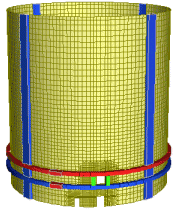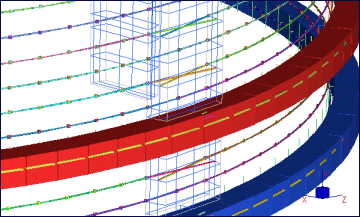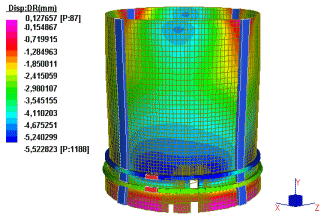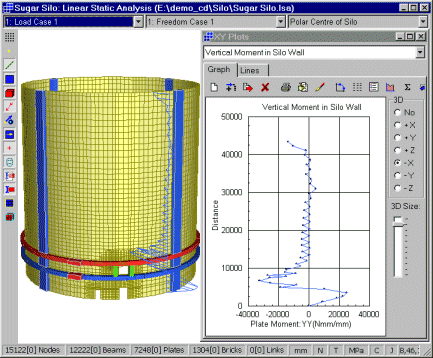Strand7 Software: Case Studies: Silo
Analysis of a 45,000 tonne sugar silo constructed from post-tensioned concrete |
Background |
| Strand7 Consulting used Strand7 to perform a finite element analysis on a 45,000 tonne sugar silo. The sugar silo has an internal diameter of 40m and an overall wall height of 44.1m. The silo wall is constructed of 350mm thick concrete and post-tensioned between diametrically opposite buttresses. There are four buttresses spaced 90 degrees apart. The tendon hoop spacing varies up the height of the silo wall. The first tendon hoop is anchored at the West and East
buttresses. The anchorage of the next tendon hoop alternates to the North and East buttresses. This alternating of anchorage between buttresses continues up the height of the silo wall. |
 |
Each silo wall tendon consists of 19 x 12.5 mm diameter, super grade, low relaxation, stress relieved strands. The tendons are fully encapsulated in polyethylene ducts. The existing silo wall tendons were originally post-tensioned to 2,515 kN with friction losses in the anchorage of 6%. The wall tendons have design friction losses of 16%, along the tendon to the mid-point between opposite buttresses. |
| Each ring beam tendon in both of the proposed ring beams is to be post-tensioned to 2,530 kN (i.e. 5,060 kN per ring beam), with friction losses of 12% in the anchorage. The ring beam tendons have design friction losses of 19% along the tendon to the mid-point between opposite buttresses. |
Scope of work |
| The principal aim of this analysis was to evaluate the effectiveness of proposed ring beams when opening two new access doors in the silo wall. The door opening at the floor slab level requires the cutting of three
post-tensioned tendons. |
| An important part of the brief was to ensure that at each stage, and subsequent stages of the construction sequence, the modelling technique accounted for the cumulative state of strain. That is, the state of strain in
the silo wall and ring beams at each construction stage needed to be correctly super-positioned to the next stage of construction. |
Construction sequence |
|
Model |
| These types of silo structures are typically analysed using circumferential line loads (acting radially inwards). To ensure an accurate prediction of the cumulative state of strain with each subsequent stage of construction an alternative method of tendon load application was used. The technique used was to model every single tendon in the silo wall (80 in total). The two tendons in each ring beam were modelled using one tendon (but with the equivalent post-tension load). All 40 post-tensioned tendon hoops as well as the tendons in the ring beams were modelled using truss elements, with appropriate values for the E and A. |
 |
The finite element model of the sugar silo was prepared using a combination of beam elements (for the post-tensioned tendons, the upper and lower ring beams and offset beams), thin shell plate elements (for the silo wall) and brick elements (for the buttresses). |
| The mesh grading was based on the spacing of the tendon hoops (which varied up the height of the silo wall). In general, the mesh grading resulted in the plate elements being virtually square. A pinned freedom condition was applied around the base of the silo since the footing of the silo is continuous and piled around the circumference. |
| The ring beams were modelled using beam elements with appropriate values for E, A, I11, I22, G and J. These were offset from the silo wall using truss elements. |
| The post-tensioning of the tendons was achieved by assigning a pre-tension attribute to the tendon anchored in the buttresses. The linear static solver was run to calculate the tension in the tendons. The pre-tension value for each tendon was then adjusted until the correct post-tension was achieved (to within a tolerance of 0.01%). The tendons were offset from the silo wall using truss elements. The function of the offset beams is to model the eccentricity of the tendons with respect to the centre line of the silo wall and to allow the tendons to slide relative to the silo wall. |
| The friction losses along the length of the tendons were modelled using an axial uniformly distributed load, applied from the buttresses to the centre of the silo. |
Statistics |
| Nodes | : | 15122 |
| Beams | : | 12222 |
| Plates | : | 7248 |
| Bricks | : | 1304 |
| Equations | : | 62645 |
|
| The Linear Static Solver was used to analyse the sugar silo. The output results were checked for plausibility of deformation and overall stress magnitudes, contours and local stress concentrations. |
| The maximum vertical bending moments in the silo wall adjacent to the ring beams were found by automatically extrapolating the data at the Gauss points on a number of plates either side of the ring beams. |
 |
Graphs of the bending moments in the silo wall and proposed ring beams, as well as the radial displacement at the floor slab level were prepared. |
 |

 Menu
Menu